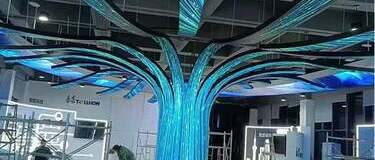1. What is LED?
LED is the English abbreviation of LIGHT EMITTING DIODE (LIGHT EMITTING DIODE), the display industry said LED refers to the LED that can emit visible bands.
2. What is a pixel?
A pixel is the smallest imaging unit of a display screen, generally consisting of a single or multiple light-emitting diodes. For example, some display design schemes write pixels: 2R1G1B, which means the smallest imaging unit of the display screen, is composed of two red light emitting tubes, one green light emitting tube, and one blue light emitting diode (in the display industry, red, green, and blue light emitting tubes are used to use their English letters, R, G, and B instead), P represents the point spacing, and ∮ represents the point diameter.
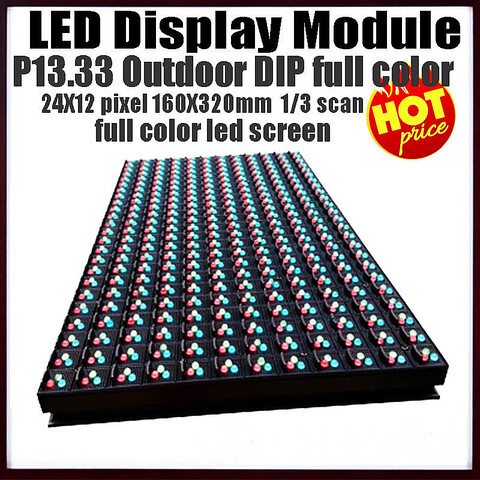
3. What is pixel distance (point distance)?
The center distance between two adjacent pixels, the smaller the distance, the shorter the visual distance. People in the industry usually refer to the P for the point spacing.
4. What is pixel density?
Pixel density, that is, the number of pixels per inch of the screen, the higher the pixel density, the more detailed the display.
5.What is the LED display module?
The LED module is composed of a light emitting diode quadrilateral module integrated with a plurality of rows and columns. At least one side of the quadrilateral module is an edge with more than one set of concave and convex groove blocks. The quadrilateral module can have at least one group of opposite sides and two walls with a group of above concave and convex groove blocks, wherein the two pairs of edge concave and convex groove blocks can be corresponding or symmetrical.
6. What is DIP?
DIP package, is the abbreviation of dual inline-pin package, also known as dual in-line packaging technology, dual in-line packaging, a form of DRAM component packaging. It refers to the integrated circuit chip that uses the dual-in-line package, and the vast majority of small and medium-sized integrated circuits use this package, and the number of pins is generally not more than 100.
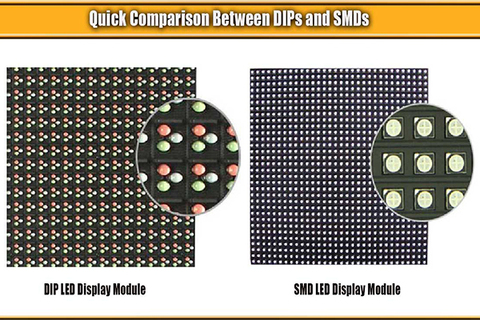
7. What is SMT? What is SMD?
SMT is SURFACE assembly technology (short for SURFACE MOUNTED technology), is currently the most popular technology and process in the electronic assembly industry. SMD is an abbreviation for surface mounted device, meaning: surface mount device.
8. What is the LED display module?
LED display module is one of the main components of the finished LED display! Mainly composed of LED lights, PCB boards, driver ics, resistors, capacitors and plastic kits!
9. What is LED Screen?
LED Screen (LED display) is a flat panel display, composed of a small LED module panel, used to display text, images, video, video signals and other information equipment.
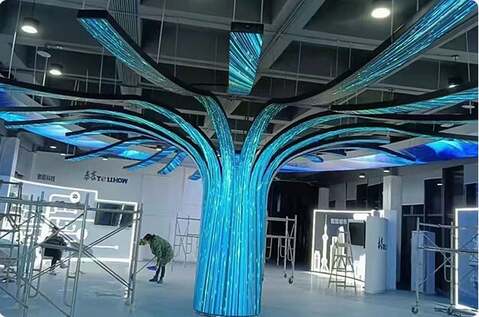
10.What is the plug-in lamp module, what are the advantages and disadvantages?
Refers to the DIP package of the lamp foot through the PCB board, through welding the tin filled in the lamp hole, the module made by this process is the plug lamp touch group, the advantages are: high brightness, good heat dissipation, the disadvantage is that the pixel density is small.
11.What is a sticker module? What are the advantages and disadvantages?
Table paste is also called SMT, the SMT package of the lamp is welded on the surface of the PCB board through the welding process, the lamp foot does not have to pass through the PCB board, the module made of this process is called the table paste module, the advantages are: good display effect, large pixel density, suitable for indoor viewing: the disadvantage is that the brightness is not high enough, the lamp itself is not good enough heat dissipation.
12.What is the subsurface paste module? What are the advantages and disadvantages?
Subsurface paste is a product between DIP and SMT, its LED lamp packaging surface and SMT, but its positive and negative pins and DIP, the production is also through the PCB to weld, its advantages are: high brightness, display effect is good, the disadvantage is: complex process, difficult maintenance.
13.what is the brightness of the LED display?
The brightness of the LED display screen refers to the luminous intensity of the display unit area when the display is working normally, the unit is cd/ m2 (that is, how many cd luminous intensity per square meter area, "cd" Chinese called Candela, m2 Chinese called square meter). Indoor video screen brightness is generally between 200 and 1200cd/m2. Outdoor video screen brightness is generally between 3000 and 7000cd/m2.
14.What is 3 in 1? What are its advantages and disadvantages?
Refers to the RGB three different colors of LED chip packaging SMT lights in accordance with a certain distance vertical side by side, so that not only has all the advantages of 3-in-1, but also can solve the various shortcomings of 3-in-1: complex process, difficult maintenance.
15.What is double primary color, false color, full color display?
Through different colors of light emitting diodes can be composed of different display, double primary color is composed of red, green or yellow green two colors, false color is composed of red, yellow green, blue three different colors, full color is composed of red, pure green, pure blue three different colors.
16. What is luminance?
Luminous intensity is referred to as light intensity, the international unit is candela (Candela) short for cd, other units have candlelight, branch light. 1cd, or 1000mcd, is the luminous flux emitted by a unit solid Angle of a monochromatic light source (frequency 540X10^12HZ) in a given direction (radiation intensity in that direction is (1/683) watts/sphericity).
17. What is brightness level?
The number of manual or automatic adjustments between the lowest and highest brightness of the entire screen.
18.What is the gray level?
The gray level of the LED display is an indicator of the image level of the display screen. The gray level of the video screen is generally divided into 64 levels, 128 levels, 256 levels, 512 levels, 1024 levels, 2048 levels, 4096 levels. The higher the gray level, the clearer the image level, the general gray level above 256, the image difference is not very big. The gray level depends mainly on the A/D conversion number of the system.
19.What is the maximum brightness?
Under certain ambient illumination, each primary color of the LED display is at the maximum brightness and maximum gray level.
20. What is Moire pattern?
When shooting the full-color LED display at work, there will be some irregular water ripples on the LED display screen, and these water ripples are called "Moore patterns" in physics. A Moire stripe is a stripe of high frequency interference that occurs in the photosensitive elements on devices such as digital cameras or scanners. It is a stripe of high frequency irregularity that causes the image to appear in color. Because the Moire pattern is irregular, there is no obvious shape rule.
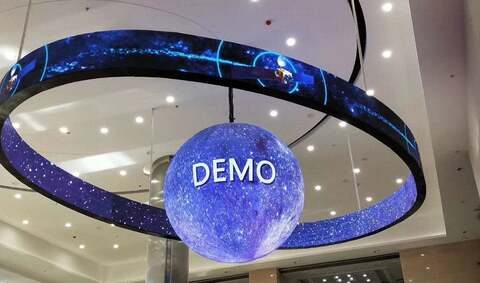
21.What is PCB?
PCB (Printed Circuit Board), the Chinese name is called printed circuit board, also known as printed circuit board, is an important electronic part, is the support body of electronic components, is the carrier of electrical connection of electronic components. Because it is produced by electronic printing, it is called a "printed" circuit board.
22.What is the unit board specification?
Refers to the size of the cell board, usually expressed as the cell board length multiplied by the width of the expression, in millimeters. (48×244)
23.What is the resolution of the unit board?
Refers to the number of pixels in a cell board, usually expressed by the number of rows multiplied by the number of columns of cell board pixels. (e.g. 64×32)
24.What is BOM?
Bill of Material (BOM), the use of computer-aided enterprise production management, first of all, to enable the computer to read the composition of the products manufactured by the enterprise and all the materials involved, in order to facilitate computer identification, it is necessary to use the graphical expression of the product structure into a certain data format, This document that describes the product structure in data format is the bill of Materials, or BOM. It is a technical document that defines the product structure, so it is also called the product structure table or product structure tree. In some industries, it may be called "recipe", "factor list", or some other name.
25.What is white balance, what is white balance regulation?
The white balance we say refers to the balance of white, that is, the balance of the brightness ratio of the three RGB colors. The adjustment of brightness ratio and white coordinate of the three colors of RGB is called white balance adjustment.
26.What is contrast?
Under a certain ambient illumination, the ratio of the maximum brightness and background brightness of the LED display.
27.What is color temperature?
The color emitted by the light source is the same as the color of the radiation of the blackbody at a certain temperature, and the temperature of the blackbody is called the color temperature of the light source.
28.What is color difference?
LED display by the combination of red, green and blue to produce a variety of colors, but the three colors are made of different materials, the viewing Angle is different, the spectral distribution of different leds are changed, these differences can be observed called color difference. When the LED is observed at a certain Angle, its color changes, and the ability of the human eye to judge the color of the real picture (such as a movie picture) is better than that of the computer-generated picture.
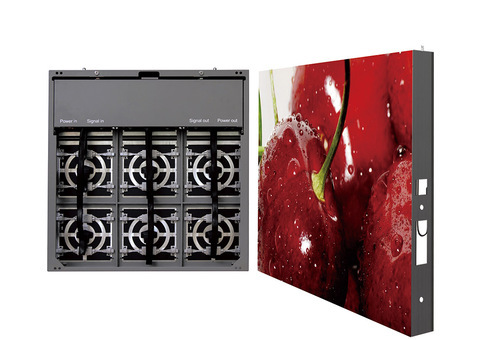
29.What is the frame change frequency?
Number of times the display information is updated per unit time.
30. What is refresh frequency?
The number of times the display screen is repeated by the display screen in the unit time.
31.What is perspective? What is viewable? What is the best view?
The viewing Angle is when the brightness of the viewing direction drops to 1/2 of the brightness of the normal line of the LED display. The Angle between two observed directions and the normal direction of the same plane. It can be divided into horizontal and vertical angles. The Angle of view is just the direction of the image content on the display screen, and the Angle formed by the normal line of the display screen. The best Angle of view is to be able to just see the content on the display screen, without flat color, and the Angle between the clearest direction and the normal of the image content.
32.What is the best visual distance?
It is able to see the content on the display just completely, without flat color, and the position of the image content is the clearest relative to the vertical distance of the screen:
33. What is a runaway point? How many kinds?
Luminous state and control requirements do not meet the pixel points, out of control points are divided into: blind spot (also known as dead point), often bright (or dark) flash point three.
34.What is static drive? What is Scan Driver? What's the difference between the two?
The "point-to-point" control between the output pin of the driver IC and the pixels is called a static drive, and the "point-to-column" control between the output pin of the driver IC and the pixels is called a scan drive, which requires a row control circuit: it can be clearly seen from the driver board: Static drive does not need line control circuit, high cost, but good display effect, good stability, low brightness loss, etc. It needs a line control circuit, but the cost is low, the display effect is poor, and the brightness loss is large.
35.What is constant current drive? What is constant pressure drive?
Constant current refers to the current value specified at the time of the constant output design in the working environment allowed by the driver IC: constant voltage refers to the voltage value specified at the time of the constant output design in the working environment allowed by the driver IC.
36.LED display general length to width ratio is what?
Graphic screen: according to the content displayed to determine.
Video screen: generally 4:3 or close to 4:3. The ideal ratio is 16:9.
37.A control system can control the number of points?
Communication screen A card: monochrome, two-color 1024×64. Communication screen B card: monochrome: 896×512 two-color: 896×256.DVI two-color screen: 1280×768. DVI full color screen: 1024×512.
38.What is nonlinear correction?
If the digital signal output by the computer is displayed without correction on the LED display, there will be color distortion, so in the system control circuit, the original computer output signal is calculated by a nonlinear function of the display required signal, because the relationship between the front and back signals is non-linear, so we often call it nonlinear correction.
39, What is the rated operating voltage? What is the operating voltage? What is the supply voltage?
The rated operating voltage refers to the voltage when the voltage is working normally. Working voltage refers to the voltage value of the electrical appliance in the rated voltage range and normal operation: the power supply voltage is divided into AC and tributary power supply voltage, our reality AC power supply voltage is AC220V-- 240V, DC power supply voltage is generally 5V DC12V solar power supply is generally 12V
40.What is color distortion?
It refers to the same object displayed in nature and on the display, and the difference between the sensory vision of the human eye.
41.What is a synchronous system and what is an asynchronous system?
Synchronous and asynchronous is relative to the computer, the so-called synchronous system, refers to the display display content and computer display synchronous display LED display control system. Asynchronous system refers to the computer edited display data stored in advance in the display control system, the computer will not affect the normal display of the LED display after shutdown, such a control system is asynchronous control system
42.What is blind spot detection technology?
Through the upper software and the underlying hardware, the blind spot (LED open circuit and short circuit) on the display can be detected, and a report is formed to tell the LED screen manager, such a technology is called blind spot detection technology.
43.What is power detection?
Through the upper software and the underlying hardware, the work of each power supply on the display can be detected, and a report can be formed to tell the LED screen body manager, such a technology is called power detection technology
44.What is brightness detection? What is brightness adjustment?
The brightness in the brightness detection refers to the ambient brightness of the LED display. Through the light sensor, the ambient brightness of the display screen is currently detected. This detection method is called brightness detection. The brightness in the brightness adjustment refers to the brightness emitted by the LED display, the detected data is fed back to the LED display control system or the control computer, and then the brightness of the display is adjusted according to this data, which is called brightness adjustment.
45.What are real pixels? What is a virtual pixel? What are the types of virtual pixels? What is pixel sharing?
Real pixel refers to the physical pixel number on the display and the actual display pixel is 1:1 relationship, the actual number of points on the display screen, can only display how many points of image information. Virtual pixel refers to the relationship between the physical pixel number of the display screen and the actual pixel number of the display 1: N (N = 2, 4), it can display image pixels than the actual pixel of the display screen 2 times or 4 times. Virtual pixels can be divided into: software virtual and hardware virtual: divided into 2x virtual and 4x virtual according to the multiple relationship, and divided into 1R1G1B virtual and 2R1G1B virtual according to the arrangement of lights on a module.
46.What is remote control? Under what circumstances is it used?
The so-called long distance is not necessarily long distance. Remote control includes that the master control terminal and the controlled terminal are in a local area network, and the space distance is not far away. And the main control end and the controlled end in a relatively far spatial distance of two, the customer requirements or according to the customer control position beyond the direct control of the optical fiber, then remote control.
47. What is fiber optic transmission? What is network cable transmission?
Optical fiber transmission is the conversion of electrical signals into optical signals using transparent glass fiber transmission, network cable transmission is the direct transmission of electrical signals using metal wires.
48.what is the use of network cable? When to use fiber optics?
When the wiring distance between the display screen and the control computer is less than 100 meters, use network cable transmission. When the distance between the two is less than 500 meters and more than 100 meters, multi-mode fiber is used, and when the distance is greater than 500 meters, single-mode fiber is used.
49.What is LAN control? What is Internet Control?
In the LAN through a computer to control another computer or connect to other external devices, this control method is called LAN control, the main controller through the controller in the INTERNET network IP address, to achieve the purpose of control, called Internet control.
50. What is DVI? What is VGA?
DVI is the abbreviation of Digital Video interface, that is, digital video interface. It is now an international common digital video signal interface.
51. What is a digital signal? What is a digital circuit?
The digital signal means that the value of the signal amplitude is discrete, and the amplitude is limited to two finite values of 0 and 1, and the circuit that processes and controls this west signal is called a digital circuit.
52. What is analog signal, what is analog circuit?
Analog signal means that the value of signal amplitude is continuous in time. The circuits that process and control such signals are called analog circuits.
53. What is PCI slot?
PCI slot is an expansion slot based on the PCI local bus (PEDPHERD component interconnect, peripheral component expansion interface). PCI slot is the main expansion slot of the motherboard, by plugging in different expansion cards can get almost all the external functions that the computer can achieve at present:
54.What is AGP slot?
Accelerated graphics interface. AGP is an interface specification that allows 3D graphics to be displayed at much faster speeds on ordinary personal computers. AGP is an interface designed to deliver 3D graphics faster and more smoothly. He uses the main memory of a regular PC to refresh the images displayed on the monitor, supporting 3D graphics techniques such as texture mapping, zero buffering and alpha blending.
55.What is GPRS, what is GSM? What is CDMA?
GPRS is a new bearer service developed on the existing GSM system through the Packet radio service (General Packet Radiosrvice), mainly used for radio communication. GSM is the abbreviation of the "Global System For Mobile Communication" standard (Global System for Mobile Communication) launched by the European Standardization Committee in 1992. It adopts digital communication technology and unified network standards to ensure the quality of communication. And can develop more new services for users to use. CODE DIVISION MULTIPLE ACCess: A new and mature wireless communication technology based on spread spectrum technology.
56.where is the use of GPRS technology for the display screen?
On the GPRS data network based on mobile communication, the data of our LED display is communicated through the GPRS transceiver module, which can achieve a small amount of remote and remote point-to-point data transmission and achieve the purpose of remote control.
57.What is USB interface
The English abbreviation of USB is UNIVERSAL SERIALBUS, which is translated into Chinese: universal serial bus. Also known as the universal series interface, it can support hot swap, can connect up to 127 PC external devices,there are two interface standards USB1.0 and USB2.0.

